HeapSort & Priority Queue 学习笔记
二项堆
二项堆(Binary Heap)指用线性数组所表示满二叉树(Complete Binary Tree)的一种数据结构。
若数组下标从 1 开始记,则有
- 若 parent 节点的下标为 N
- 则其 left child 的下标为 2N
- right child 的下标为 2N+1
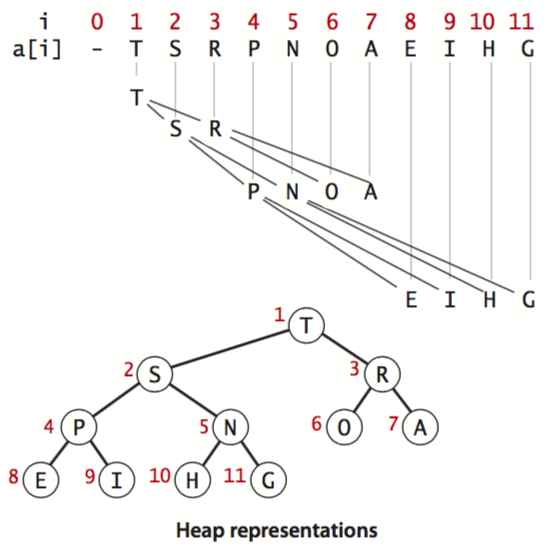
约定 parent 节点不大于(或小于)子节点,则形成了一个部分有序的堆结构
堆排序
不同于其它排序算法,需要将整个输入序列完全排序。堆排序约束一个更宽松的规则:
子树的根结点不大于(或小于)其子结点
根结点为最大值的堆称为 MaxHeap,反之称为 MinHeap
当插入新的元素,或修改堆元素的顺序后,堆的规则被破坏,需要进行维护(reheapifying),其时间复杂度为 $O(\log(n))$ 。通过循环交换第一个元素到末尾,并重新维护前 N-1 个序列的堆排序,就实现了对整个输入的排序,时间复杂度为 $O(n\log(n))$
二项堆具有以下特性
- 大小为 N 的二项堆其高度为 $\lfloor \lg{N} \rfloor$
- 长度为 N 的数据,插入操作最多进行 $ 1+\lg{N} $ 次比较,移除最大值最多进行 $2 \lg{N}$ 次比较
- 堆排序 N 个元素,最多进行 $2N\lg{N} + 2N$ 次比较
heapify
当新加入结点,或改变结点的 key 大小(调整优先级),则破坏了堆的排序条件(heap condition)。需要通过 up 或 down 两个操作来维护堆条件。以 MaxHeap 为例(根结点为最大值)
- Bottom-up reheapify (swim). 当插入或修改结点,使它的值大于 parent,则需要与 parent 互换。互换后在 parent 位置继续进行 swim 操作(递归),直到其不大于 parent 或回到了 root,如下图所示
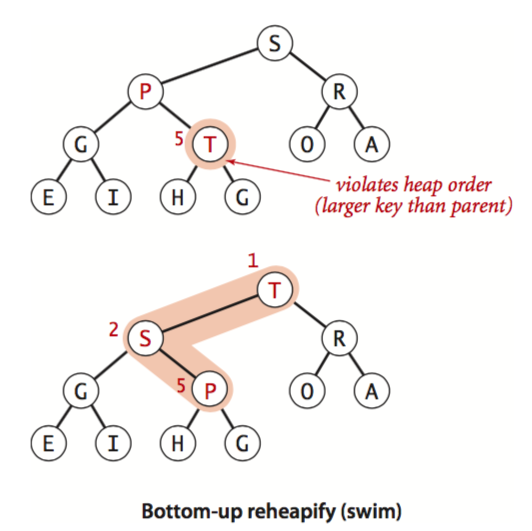
- Top-down reheapify (sink). 当结点值变小,小于了任一个子结点,则需要递归方式下沉该节点,直到两个子结点均小于它,或到达叶子结点(没有子结点)。如下图所示
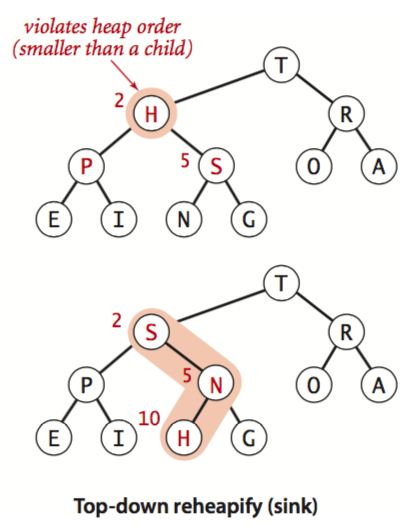
堆的两个基本操作正是基于 swim 和 sink 来实现的:
- 插入新结点。增大堆大小,插入结点到末尾,对其进行 swim 操作
- 删除最大值。将 root 与结尾元素互换,减小堆大小,对 root 进行 sink 操作
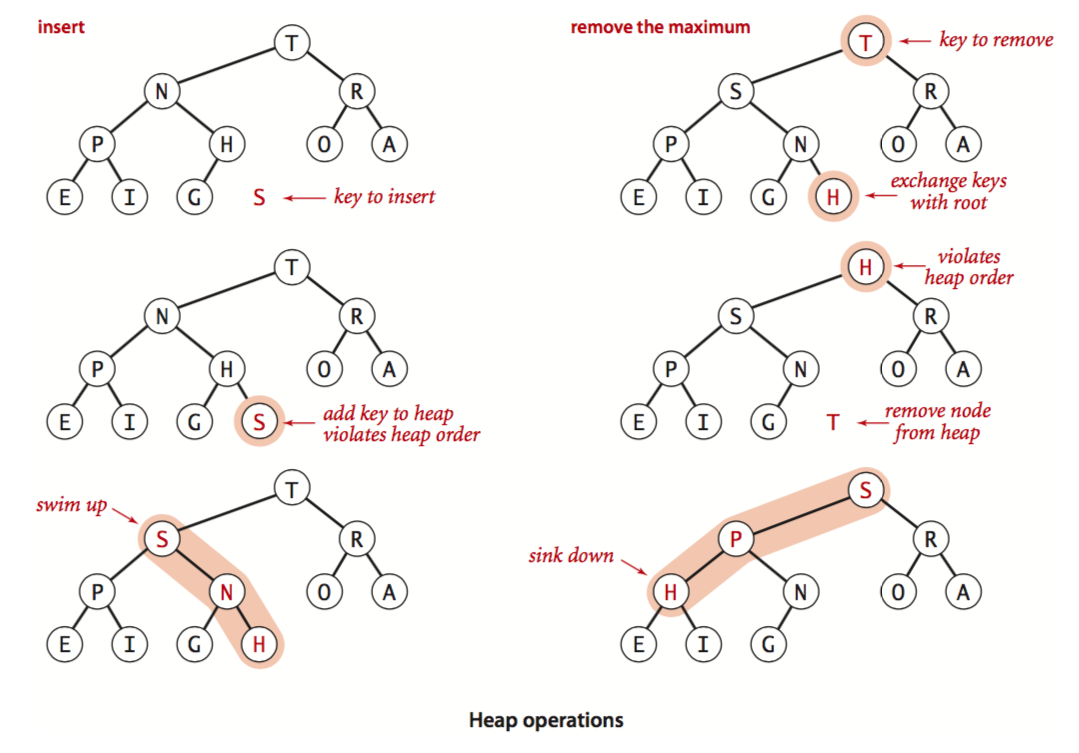
heapSort
堆排序分为两步
- heap construction, 自右向左,始终保证 subnode 符合 heap condition
- sortdown,移除首个元素(通过与最后一个元素交换,并减少堆长度,对 root 进行 sink 维护)
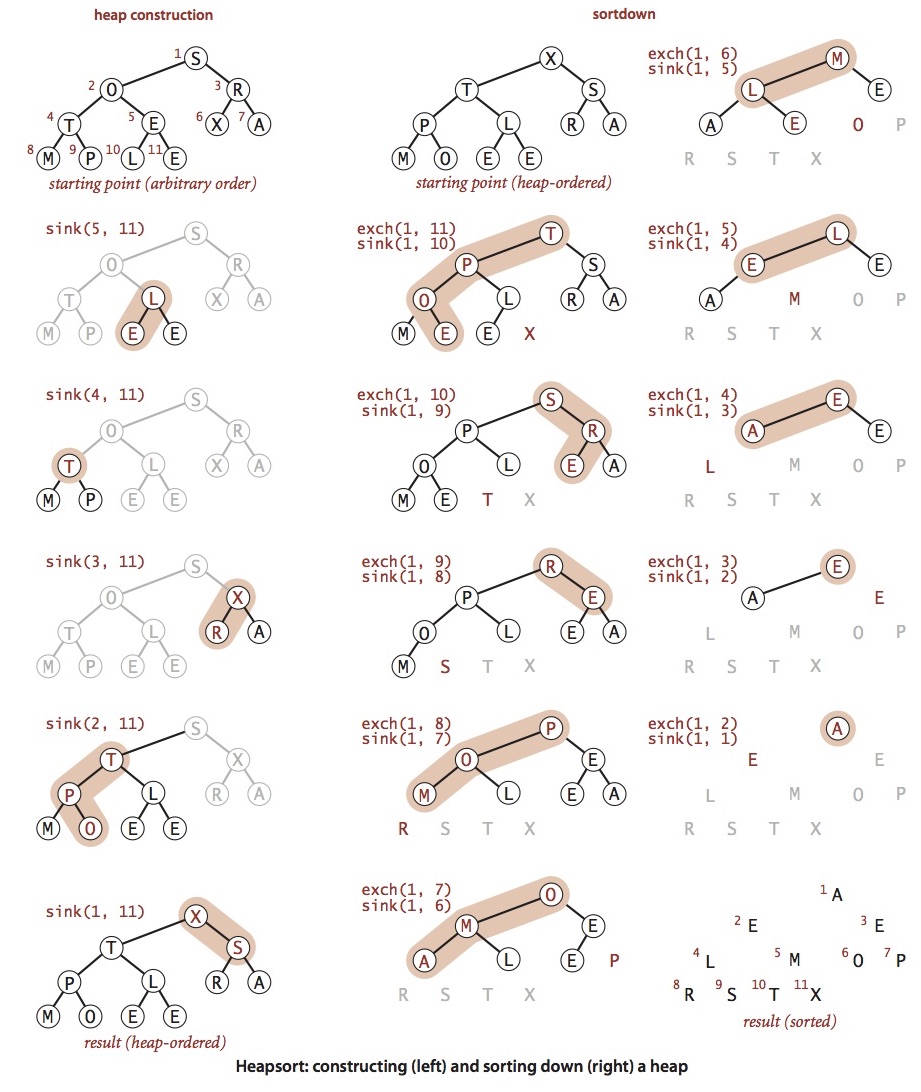
优化思路
- MultiWay Heap,可以将二项堆变成三项或更多,这样可以减少树的调试,但在 sink 时会因为子结点变多而效率相对变低
- 底层数组可以考虑动态扩展大小,不必在初始化时申请好固定大小
- 只允许增加或删除,而不允许修改
优先队列
优先级队列(priority queue)与堆排序算法密切相关。
因为可以取出其中第一个最大(或最小)的元素,常用于实现以下功能:
- 操作系统进程按优先级调用,每次取出最高优先级进程,并可以插入新的进程,或修改旧的进程优先级
- 模拟事件请求,按时间顺序触发回调
- 取无限序列的前 M 个最大值(或最小值)
- 使用 Multiway Heap 技术,可以实现多路流数据的 merge 操作
优先级队列除了堆实现外,还有一些朴素的方式来实现,如
- 选择排序思路,每次扫描全表,找出其中最大的元素
- 插入排序思路,写入时插入到合适的顺序,保证最大元素总在最后
但这些方式,或查询时间复杂度为 O(n),或插入时间复杂度为 O(n)。相比于堆排序的 O(log(n)) 在大输入量下劣势明显
go container/heap 实现
go 标准库中有 heap 的实现,
- 其中定义 heap 为 MinHeap,最小值位于 root。如果要实现 MaxHeap,则需要反转
Less效果即可 - 不同于书中使用 1 作为 root 下标,go 中使用 0 作为下标,这样结点 k 的左子为 2k+1, 右子为 2k+2,父结点为 (k-1)/2
- 优先级队列使用,提供了
Push和Pop方法,相当于 Insert 和 DelMin(因为 Less 反转相当于 DelMax)
Heap 底层与 Sort 一致,需要提供 Less, Len, Swap 三个方法,除此之外,需要向底层中添加新的元素或删除元素(与 Heap 的 Push 和 Pop 不同,是算法实现需要调用的接口方法)
type Interface interface {
sort.Interface //- embedded Interface sort.Interface
Push(x interface{}) // add x as element Len()
Pop() interface{} // remove and return element Len() - 1.
}
Heap Construction 由 Init 函数实现,与书中建议的方式一样,从右向左(忽略 $[n/2, N)$,因为其为叶子结点)添加元素,并作 sink(down)操作以维护 heap condition
func Init(h Interface) {
// heapify
n := h.Len()
for i := n/2 - 1; i >= 0; i-- {
down(h, i, n)
}
}
Push 操作插入新元素到结尾,并作 swim(up)维护
func Push(h Interface, x interface{}) {
h.Push(x)
up(h, h.Len()-1)
}
Pop 和 Remove 操作,将元素与末尾交换,减小 heap size,并对当前位置作 sink 维护
func Pop(h Interface) interface{} {
n := h.Len() - 1
h.Swap(0, n)
down(h, 0, n)
return h.Pop()
}
func Remove(h Interface, i int) interface{} {
n := h.Len() - 1
if n != i {
h.Swap(i, n)
if !down(h, i, n) {
up(h, i)
}
}
return h.Pop()
}
当修改了一个元素的大小,需要对该位置进行维护,但我们事先不知道其是增大或是减少。若增大,则需要 down 操作,否则则需要 up。Go 中的实现,为 down 添加一个 bool 的返回值,如果进行了下沉操作则返回 true。对一个元素的维护,只能是下沉或上浮中的一种,不会同时出现。
func Fix(h Interface, i int) {
if !down(h, i, h.Len()) { //- down 需要指定长度,因为要判定是否达到子结点
up(h, i) //- up 不需要指定长度,因为最多回到 root (0)
}
}
func up(h Interface, j int) {
for {
i := (j - 1) / 2 // parent
if i == j || !h.Less(j, i) { // 如果 ai <= aj,即父结点更小或相等,则不需要交换
break
}
h.Swap(i, j)
j = i
}
}
func down(h Interface, i0, n int) bool {
i := i0
for {
j1 := 2*i + 1
if j1 >= n || j1 < 0 { // j1 < 0 after int overflow
break
}
j := j1 // left child
if j2 := j1 + 1; j2 < n && h.Less(j2, j1) {
j = j2 // = 2*i + 2 // right child
} //- j 指向最大的那个子结点
if !h.Less(j, i) { // 如果 aj >= ai,即子结点大于或等于当前节点,则不需要交换
break
}
h.Swap(i, j)
i = j
}
return i > i0 // 是否发生交换
}
性能
Go 代码中列出了各个操作的时间复杂度,摘录如下
| 方法 | 时间复杂度 |
|---|---|
| Init | $O(N)$ why? |
| Push | $O(\lg{N})$ |
| Pop | $O(\lg{N})$ |
| Remove | $O(\lg{N})$ |
| Fix | $O(\lg{N})$ |
| Up | $O(\lg{N})$ |
| Down | $O(\lg{N})$ |
例子
取出最大的 N 行数据
package main
import (
"bufio"
"container/heap"
"fmt"
"os"
"strings"
)
type stringHeap []string
func (s stringHeap) Len() int {
return len(s)
}
func (s stringHeap) Less(i int, j int) bool {
return strings.Compare(s[i], s[j]) < 0
}
func (s stringHeap) Swap(i int, j int) {
s[i], s[j] = s[j], s[i]
}
func (s *stringHeap) Push(x interface{}) {
(*s) = append(*s, x.(string))
}
func (s *stringHeap) Pop() (v interface{}) {
v, (*s) = (*s)[len(*s)-1], (*s)[:len(*s)-1]
return
}
const max = 10
func main() {
h := &stringHeap{}
heap.Init(h)
for _, args := range os.Args[1:] {
file, err := os.Open(args)
if err != nil {
panic(err)
}
buf := bufio.NewScanner(file)
for buf.Scan() {
line := buf.Text()
heap.Push(h, line) // 千万注意,这里用的是 heap.Push(h,line),而不是 h.Push(line)
if h.Len() > max {
heap.Pop(h)
}
}
}
for h.Len() > 0 {
fmt.Println(heap.Pop(h))
}
}
参考资料
- Algorithm 4th Edition, 2.4 Priority Queues